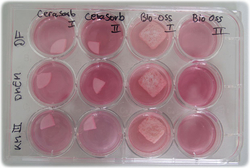You are here: Home / Cryo Competence Center Life Science / Storage | Cryobanking
Transport, Storage and revitalization of cryopreserved samples
The process chain of cell- and tissue cryopreservation is not completed with freezing of the biological samples but includes its transport, cryogen storage to its intended use, the thawing of the cryopreserved material without loss and the preparation of the revitalized samples for its intended application.
Systems for cryopreservation, transport, storage and revitalization of biological tissue
The ensuring of the sterility throughout the entire process chain, a clear assignment as well as the securing and the evidence of a complete cold chain from cryopreservation to revitalization are demanding challenges. During handling and transport of the cryopreserved samples the formation of isolating ice layers on the packaging must be prevented to ensure a gentle revitalization by suitable technical measures. With our Cryo-Rack system we offer an comprehensive technical solution, which ensures the complete process from the tissue cultivation in the bioreactor, the axenic transport and the cryobanking up to ambulant revitalizing of the frozen tissue for transplantation with mobile thawing techniques according to the terms of the medical devices act.
Strategies for sterile media change
After thawing of the biological material for the use as a tissue model for in vitro tests or medical implant, the added cryoadditives have to be removed. For this purpose we have developed perfusion devices for sterile exchange of cell culture and cryo media in our culture- and cryopreservation dishes.
Sterility-, leak- and transport safety-testings
A problem for air-transport and cryogen long-term storage of biological samples, is the demand for complete sealing and sterility of the packaging under adverse temperature and pressure conditions. We perform extensive tests to verify the tightness and the shelf life under cryogen conditions and check your biological samples in leachability studies and contamination tests, especially on the potential risk due to chemical and biological contamination.






